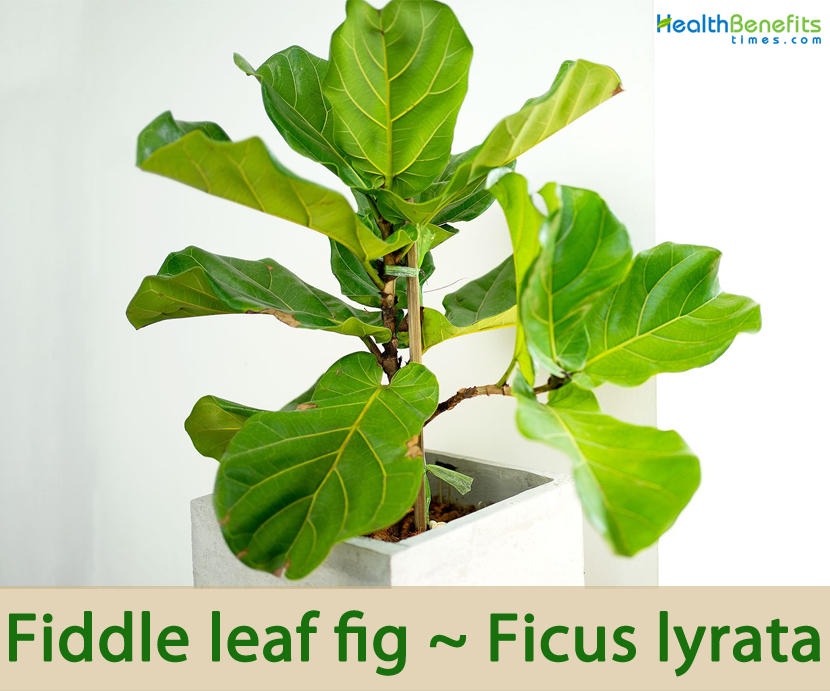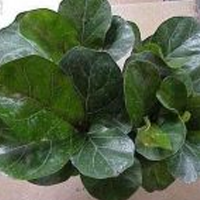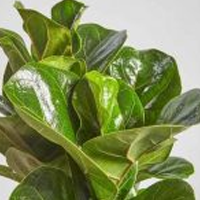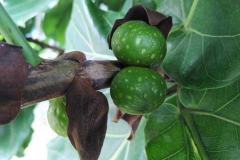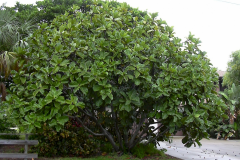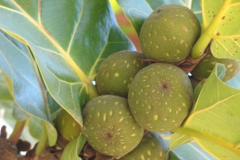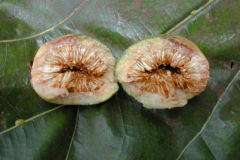| Fiddle leaf fig Quick Facts | |
|---|---|
| Name: | Fiddle leaf fig |
| Scientific Name: | Ficus lyrata |
| Origin | Western Tropical Africa (Benin, Cameroon, Gabon, Ivory Coast, Liberia, Nigeria, Sierra Leone and Togo ) |
| Colors | Green turning to brown as they mature |
| Shapes | Fig about 2.5–3 cm (1-¼ in) diameter. |
| Health benefits | Support for liver fibrosis, lower cholesterol levels, anxiety, panic, acute stress reactions and sleep disorders |
| Name | Fiddle leaf fig |
|---|---|
| Scientific Name | Ficus lyrata |
| Native | Western Tropical Africa (Benin, Cameroon, Gabon, Ivory Coast, Liberia, Nigeria, Sierra Leone and Togo where it grows in lowland tropical rainforest |
| Common Names | Banjo fig, fiddle-leaf fig, fiddle-leaved fig, lyre-leaved fig tree, Fiddle-leaf, Lyre-leaf Figtree |
| Name in Other Languages | Arabic: Fiks lirata (فيكس ليراتا) Chinese: Qín yèróng (琴葉榕) Cuba: Hoja de violin Dominican Republic: Higohonjancha Dutch: Vioolbladplant English: Banjo fig, fiddle-leaved fig tree, lyre leaf fig tree, lyre-leaved fig tree Finnish: Lyyraviikuna French: Figuier à feuilles lyrées, figuier lyre, ficus à feuilles de violon, ficus à feuilles lyrées German: Geigenfeige, Geigenblättriger Feigenbaum, geigenfeige Greek: Fíkos lyráta (Φίκος λυράτα) Hebrew: פיקוס כינורי Japan: Kashiwa bacomu, kashiwaba-gomunoki (カシワバゴムノキ) Persian: فیکوس لیراتا Portuguese: Ficus-lira, figo-da-China, figueira-lira, figueira-lirata, figueira-violino Puerto Rico: Jagüey lirado Russian: Fikus lirovidnyy (Фикус лировидный) Spanish: Arbol lira, árbol lirado, ficus lira, higuera de hojas de violin, espartaco, ficus de hoja de violin, Lirastolisti fikus Sweden: Fiolfikus Telugu: Phaikas laire (ఫైకస్ లైరెట) |
| Plant Growth Habit | Rather slow-growing, small to medium-sized evergreen tree |
| Growing Climates | Lowland rainforests, parking lots, along roads, and in parks |
| Soil | Grows in all soil types, ranging from light sandy to heavy clay soils, provided they drain well but at the same time retain the necessary moisture. A good, well-draining potting soil will provide sufficient macronutrients to the Fiddle-Leaf Fig and help it thrive and grow |
| Plant Size | Up to 12m height when grown in ground, but can reach 30m in native habitat |
| Bark | Very rough bark of dark greyish brown color |
| Trunk | Solitary, with greyish shallowly-cracked bark |
| Leaf | Grooved petiole is thick and glabrous, with a length of between 2- 5 cm (0.8-2 in). The lamina is large, simple with leathery texture and a wavy margin. They are nice dark green in color. The leaves are relatively thick and have a pronounced reticulate venation, consisting of a strong midrib and 8 to 10 second order veins. |
| Flower | Flowers are minute, numerous, hidden on inner wall of synconium receptacles. The plant is monoecious, with male / gall (sterile) and female flowers found in separate synconiums on the same tree. The males consist of 2 to 3 sepals of ovate-lanceolate shape and bear a solitary stamen with ovoid anther. |
| Fruit Shape & Size | Fig about 2.5–3 cm (1-¼ in) diameter |
| Fruit Color | Green when young turning to brown |
| Propagation | By division, By stem cuttings, and By air layering |
| Varieties |
|
| Lifespan | More than 50-70 years in Wild For 25-50 years indoor |
Plant Description
Fiddle leaf fig is a rather slow-growing, small to medium-sized evergreen tree that normally grows up to 12–15 m (39–49 ft.) tall when grown in ground, but can reach 30 m (98 ft.) in native habitat. Normally the annual growth rate is moderate and does not exceed 15 m high (50 ft.). It consists usually of a single trunk and a canopy of spherical or hemispherical shape, which is symmetrical with an irregular outline. As an indoor plant it gets significantly smaller dimensions and has rather upright appearance. The plant has numerous tuberculous and glamorous young shoots.
The plant is found growing in lowland rainforests, parking lots, along roads, and in parks. The plant grows in all soil types, ranging from light sandy to heavy clay soils. A good, well-draining potting soil will provide sufficient macronutrients to the Fiddle-Leaf Fig and help it thrive and grow. It also prefers full sun but takes bright shade when young. Avoid overwatering and do not allow plant to stand in excess water to prevent root rot. Too much or too little water and insufficient light will result in dying of lower older leaves. Interestingly, this fig can also be grown as a house-plant in a pot. It can also grow as a free-standing tree on its own.
Trunk & Branches
In its natural state it has single or many trunks and very rough bark of dark greyish brown color. They are spreading or upright, thick, having a reddish brown color which when matured becomes greyish brown. Stems have a milky sap.
Leaves
The grooved petiole is thick and glabrous, with a length of between 2- 5 cm (0.8-2 in). The lamina is large, simple with leathery texture and a wavy margin. They are nice dark green in color. The leaves are relatively thick and have a pronounced reticulate venation, consisting of a strong midrib and 8 to 10 second order veins.
Their shape is similar to a lyre or a fiddle, obovate with a pair of sinuous indentations near the base, and is mainly arranged alternately. Their length is between 15 and 30 cm (6-12 in) and their width between 12 and 20 cm (4.7-7.8 in) grooved by deep veins, with about 4 cm long, triangular and persistent stipules (appendages at the base of the leafstalk whose main aim is to protect the leaf during the initial stage of its growth). The leaf shapes can be different for different stages of life, a fairly unique characteristic. In fact, most other plants’ leaves make the same shapes throughout their lives.
| Leaf arrangement | Alternate |
| Leaf type | Simple |
| Leaf margin | Undulate, entire |
| Leaf shape | Obovate |
| Leaf venation | Pinnate, brachidodrome |
| Leaf type and persistence | Evergreen, broadleaf evergreen |
| Leaf blade length | 8 to 15 inches |
| Leaf color | Dull green on top, paler green underneath |
| Fall color | No color change |
| Fall characteristic | Not showy |
Flowers
The flowers are produced in the interior of an axillary inflorescence. Flowers are minute, numerous, hidden on inner wall of synconium receptacles. The plant is monoecious, with male / gall (sterile) and female flowers found in separate synconiums on the same tree. The males consist of 2 to 3 sepals of ovate-lanceolate shape and bear a solitary stamen with ovoid anther. The females consist of 3 ovate-shaped sepals and have a short style with papillate stigma. Fiddle Leaf Fig Tree is completely pollinated by the wasp Agaon spatulatum.
| Flower color | Unknown |
| Flower characteristics | Not showy; emerges in clusters inside of the syconium produced by this tree |
Fruits
Fertile flowers are followed by a green fig about 2.5–3 cm (1-¼ in) diameter. It reproduces by seed, but more frequently by cutting, in a sandy substratum at the temperature of 22-24 °C, and by air layering in early summer. Fruit is rarely seen on plants outside of the native habitat.
| Fruit shape | Round |
| Fruit length | ½ inch |
| Fruit covering | Fleshy fig with creamy white dots |
| Fruit color | Turns from green to red when ripe |
| Fruit characteristics | Does not attract wildlife; not showy; fruit/leaves a litter problem |
Fiddle Leaf Fig Tree Varieties
1. Ficus lyrata ‘Suncoast‘
It is a variety that is more tolerant to cold than the typical species. The minimum temperature at which it can be exposed without damage is -1.1 °C (30 °F). In terms of dimensions, it reaches the height of 3 to 4 m (9-12 ft) while its diameter varies between 2 and 3 m (6-9 ft).
2. Ficus lyrata ‘Compacta’
As its name implies, it has a compact appearance. It is a slower growth rate than the typical species, which means that transplantation needs to be done in less time. Its dimensions, if planted outdoors, are 8 to 10 m (26-32 ft.) in height and 6 to 8 m (20-26 ft.) in diameter.
3. Ficus Lyrata ‘Bambino’
Extremely compact variety derived from natural mutation of the parent plant, which was grown in the Dutch De Wilgenlei nursery. Its leaves are more obovoid in shape than that of the Lyra, while their dimensions range from 14 to 21 cm (5.5-8.2 in) in length, with a width of 13 to 18 cm (5-7 in).
4. Ficus lyrata ‘Variegated’
This is a highly decorative variety with leaves that have yellow-creamy edges. It is also of a slow growth rate.
Fiddle leaf fig Image Gallery
Health benefits of Fiddle leaf fig
Many of us own fiddle leaf figs or other houseplants purely because they’re beautiful and fun to care for. And that’s reason enough! But there are many benefits of owning a fiddle leaf fig or other indoor plant. Here are just a few of the reasons why fiddle leaf figs make a great addition to your home and can improve your physical and mental health.
1. Clean the air
You’ve probably heard that many indoor houseplants can remove chemicals such as formaldehyde, ammonia, and benzene from indoor air better than any technology can, as well as promoting healthy oxygen levels as they respirate. According to this NASA study, many plants, including ficus trees such as ficus lyrata, are effective at cleaning air and removing harmful chemicals. Fiddles can also grow quite large, and larger plants respire more than smaller ones, making them more effective at cleaning indoor air. If you want to breathe easy in your home, try a fiddle leaf fig!
2. May boost concentration
The mental benefits of fiddle leaf figs don’t just stop at well-being! Fiddles and other houseplants may also increase focus and productivity.
Scientific research has found that elementary students were more attentive and better able to focus when their classroom contained live houseplants (as opposed to artificial plants, images of plants, or no plants at all). Try hanging out around your fiddle when you’re trying to focus. You just might notice a difference in your ability to concentrate!
3. Protect liver and lower cholesterol level
Fiddle leaf fig is a rich source of antioxidants like flavonoids and phenols. These antioxidants treat liver fibrosis (accumulation of cells and collagen in the liver) and lower cholesterol levels (10).
4. Treat central nervous system disorder
Chromone, flavonoids, and β-sitosterol found in fiddle leaf fig can slow brain activity. It is useful for treating anxiety, panic, acute stress reactions, and sleep disorders. Moreover, it also increases the output of excess fluid, mainly water and sodium, by urine. Thus this plant prevents kidney stone formation.
5. Stress Reduction & Productivity Booster
Research published in the Journal of Environmental Horticulture demonstrates that interacting with houseplants enhances cognitive function by enhancing memory and focus. According to this study, indoor plants like Ficus lyrata at work locations can improve productivity and facilitate employee work.
6. Improves Sleep
During the process of photosynthesis, the large leaves of fiddle leaf figs produce and emit an abundance of oxygen. Photosynthesis stops during the night when there’s no sunlight to catalyze the process, and the plant can then begin emitting some carbon dioxide.
However, fiddle leaf figs produce so much oxygen during the day that overall, they increase the oxygen content of your indoor environment. As a result, they can help improve your sleep because an abundance of oxygen encourages the brain to stay in a restful, restorative state of deep sleep.
7. Has Antibacterial Properties
Studies have found that certain compounds extracted from fiddle leaf fig plants exhibit impressive antibacterial properties when tested against a variety of bacterial strains.
Different Benefits of Fiddle Leaf Fig Tree Plants
1. Use in Feng Shui
In feng shui, fiddle leaf fig plants are said to offer a variety of benefits. Their softly edged, rounded leaves attract positive, nourishing energy into an indoor space. This makes them a good solution for neutralizing the negative energy of dark spaces, blocked corners, and sharp edges in a home or office.
Additionally, fiddle leaf fig plants symbolize abundance and good luck. Placing one in the wealth (southeast) or career (north) corner of your Bagua map can help you attract good fortune and wealth in these areas of your life.
2. Low-Maintenance Care
Fiddle leaf figs can be tricky to grow if your home does not provide the right growing environment (i.e. 30-65% humidity, a steady temperature between 60°F and 85°F, moderate moisture, and bright but filtered sunlight).
However, given good indoor growing conditions, fiddle leaf figs require little care and maintenance, making them a good choice if you have an otherwise busy lifestyle.
They do not require regular pruning, except to control the growth of the plant when desired and to remove dead or dying leaves. To encourage even growth and prevent your plant from leaning (or leaf drop), set a reminder on your calendar to rotate your fiddle leaf fig plant 25 degrees every week. It’s also prudent to remove any excess dust build-up on your fiddle leaf fig’s leaves each month.
3. Ornamental Value
Fiddle leaf fig trees are popular home and office decorating options due to their impressive ornamental value. Whether you have a small fiddle leaf fig, a 10-foot fiddle leaf fig, a full fiddle leaf fig, or a spindly and sparse fiddle leaf fig, you are going to add some major visual impact to your home.
No matter the size of your plant, fiddle leaf fig leaves grow large and green and have a leathery texture with delicately wavy edges. Place large plants on the floor in brightly lit corners and small plants on end tables everywhere.
4. Good Choice for Pollen Allergy Sufferers
Fiddle leaf fig plants do contain some latex that can irritate individuals with allergies and sensitivities to latex. When handled directly, they can lead to skin irritations and, when these particles are breathed in through the air, they can cause respiratory reactions.
However, fiddle leaf fig plants are a good choice for homes of people who suffer from allergies to different types of pollen because these plants do not typically produce flowers when they are grown indoors.
5. Resistant to Drought
If you’re busy and/or forgetful, then a fiddle leaf fig might be the right choice for you because this drought-tolerant plant can withstand going without water for some time. Although they prefer to be watered regularly, fiddle leaf figs are prone to root rot and need well-draining soil to stay healthy. Don’t be afraid to let your plant’s soil dry out completely in between watering.
6. Filters Odors
Since fiddle leaf fig plants can remove foul-smelling toxins from the air like formaldehyde and benzene, they also freshen the air, improving its smell.
7. Improves Indoor Acoustics
The leaves, stems, and branches of plants actually help to absorb sound waves traveling through an indoor environment. Large, broad leaves, like those produced by fiddle leaf figs; provide exceptionally efficient absorption of sound waves, improving the acoustics of your indoor environment.
Other Facts
- This plant has gained the Royal Horticultural Society’s Award of Garden Merit.
- Fiddle leaf fig is grown in tropical regions as an ornamental and shade tree.
- In Hawaii the species has been cultivated for use in shady landscapes or indoor conditions.
- Bark of the species has been used for its gums/resins.
- Tree is used as an ornamental or cultivated plant, a shade tree, and an indoor houseplant, and is also known to have social significance, as it is used in some cultures in magic (fetish tree).
- Fiddle leaf figs are ranked among the luckiest of plants, bolstering longevity, happiness, and prosperity.
- They brighten up the atmosphere of a home or office, which improves the mindset overall.
- Fiddle leaf fig is popular as an indoor potted plant and is often used in interior design and styling.
Precautions
- If ingested this plant can be toxic or poisonous so keep away from dogs, cats or other pets and small children.
- All cut or bruised plant surfaces exude a milky sap that may cause skin irritation in susceptible individuals, and is toxic if ingested.
- People with a history of asthma are likely to develop allergic reactions, when the sap get on dust particles and fly throughout the house or office.
- Fiddle leaf fig irritates eyes and irritates skin.
- If ingested, they can cause severe gastrointestinal upset and also irritate the soft tissues of the digestive system.
- When handled without wearing gloves, the plant’s calcium oxalate crystals can also burn and irritate the skin.
Prevention and Control
Due to the variable regulations around (de)registration of pesticides, your national list of registered pesticides or relevant authority should be consulted to determine which products are legally allowed for use in your country when considering chemical control. Pesticides should always be used in a lawful manner, consistent with the product’s label.
Prevention
The species requires a specialist pollinator wasp in order to set viable seed. Especially in places where Fiddle leaf fig has been introduced, it is a high priority to prevent the wasp from entering non-native areas in order to prevent the species’ spread.
Physical Control
Species can be physically controlled by pruning to prevent the plant from maturing into a woody shrub or tree-like form. However, like other Ficus species, it can spread vegetatively, so grazing and burning are not the most effective methods for such Ficus species.
Chemical control
Fig trees are particularly sensitive to triclopyr herbicides as a basal or cut-stump treatment. Trees found growing on concrete or rock structures should be treated with herbicide while young to avoid costly structural damage. Use extreme caution when applying herbicide to figs growing as epiphytes to ensure that the poison does not contact the host tree. When exotic figs germinate high in the branches of large trees in natural forest communities, it may be extraordinarily difficult to get close enough to the fig to treat it.”
Biological control
Nadel et al. (1991) report several pests that could be looked at for biological control potential including various ants which were seen carrying off pollinator wasps from Ficus fruits, Hymenoptera and mites that may be parasites of the pollinator wasps, and staphylinids which were seen entering Ficus fruits and eating the pollinator wasps. Dehgan report that scales tend to be a problem.
Cultural control
The pollinator wasps should be prevented from entering Hawai’i in order to prevent spread of Fiddle leaf fig. Other native or non-harmful non-native trees could be planted.
References:
https://en.wikipedia.org/wiki/Ficus_lyrata
https://www.cabidigitallibrary.org/doi/10.1079/cabicompendium.24125
http://www.stuartxchange.com/FiddleLeaf
http://www.flowersofindia.net/catalog/slides/Fiddle%20Leaf%20Fig.html
https://indiabiodiversity.org/species/show/229726
http://www.theplantlist.org/tpl/record/kew-2811182
https://gd.eppo.int/taxon/FIULY
https://edis.ifas.ufl.edu/publication/ST254
https://www.missouribotanicalgarden.org/PlantFinder/PlantFinderDetails.aspx?taxonid=282753
https://www.itis.gov/servlet/SingleRpt/SingleRpt?search_topic=TSN&search_value=507895#null
https://plants.usda.gov/home/plantProfile?symbol=FILY


